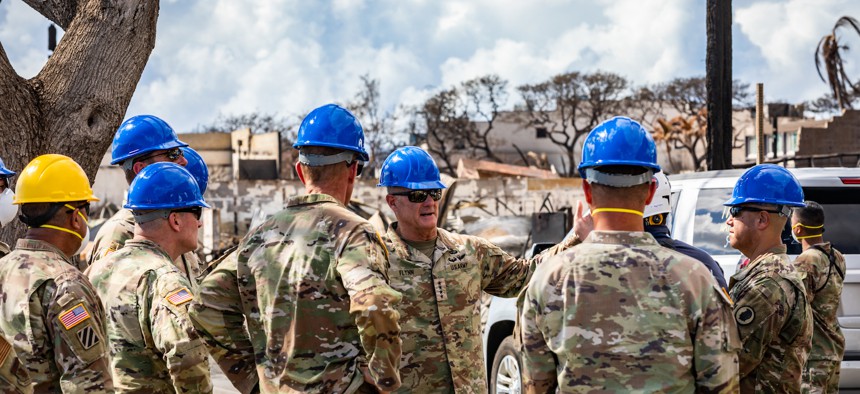
U.S. Army Gen. Charles A. Flynn, commanding general of the U.S. Army Pacific, alongside the command element of the Combined Joint Task Force 50 (CJTF-50) meets with search, rescue and recovery personnel in Lahaina, Maui, Aug. 15, 2023. U.S. Army National Guard / Staff Sgt. Matthew A. Foster
Hundreds of DOD personnel supporting Maui recovery efforts
Death toll in the devastating wildfires has risen to 111, with more than 1,000 people still missing.
Some 700 troops and defense employees are helping the people of Maui recover from the devastating wildfires, with support equipment on standby to assist, the Pentagon’s spokesman said Thursday.
U.S. Army Pacific Command is running Combined Joint Task Force 50, which “is now at full operational capability and is actively synchronizing all DOD support to disaster relief operations,” Air Force Brig. Gen. Pat Ryder told reporters at the Pentagon. Army National Guard Brig. Gen. Stephen Logan was named Tuesday to head that task force.
U.S. Army Pacific is doing six missions for the Federal Emergency Management Agency, or FEMA, including air and sea transportation between the Hawaiian islands to move supplies and people, and using the Army’s Schofield Barracks on Oahu to house responders and the Army Reserve Center-Wailuku on Maui as a staging area, Ryder said. The U.S. Army Corps of Engineers is also “managing two operational FEMA mission assignments for debris removal and temporary power,” he said.
The death toll from last week’s wildfires has risen to at least 111 people as of Wednesday and more than 1,000 still missing, the Honolulu Star-Advertiser reported. President Joe Biden and First Lady Jill Biden will visit Maui Monday to meet with survivors of the fires, first responders, and local officials, the White House announced Wednesday.
The Defense Department has nearly 700 active duty, Reserve, National Guard, and civilians helping with the wildfire response effort, alongside about 140 U.S. Coast Guardsmen, Ryder said. The Hawaii National Guard has teams supporting search and recovery efforts, as well as troops helping law enforcement with the security of Lahaina and traffic control. Air crews from the Hawaii National Guard have dropped more than 189,000 gallons of water to fight the fires, Ryder said, and still has two CH-47 Chinook helicopters on standby with aerial fire suppression buckets.
The U.S. Navy and Marine Corps also have aviation assets on standby for future requests, including MH-60R Seahawk helicopters, V-22 Ospreys, KC-130J Super Hercules aircraft, and an MQ-9 drone for “aerial survey,” Ryder said.
The 3rd Marine Littoral Regiment, a new type of unit created to do Expeditionary Advanced Base Operations, has also “been made available to provide manpower, engineering, and water purification support as needed,” he said.




